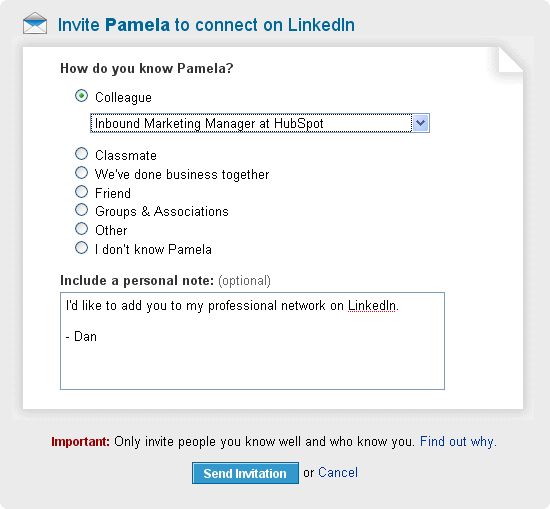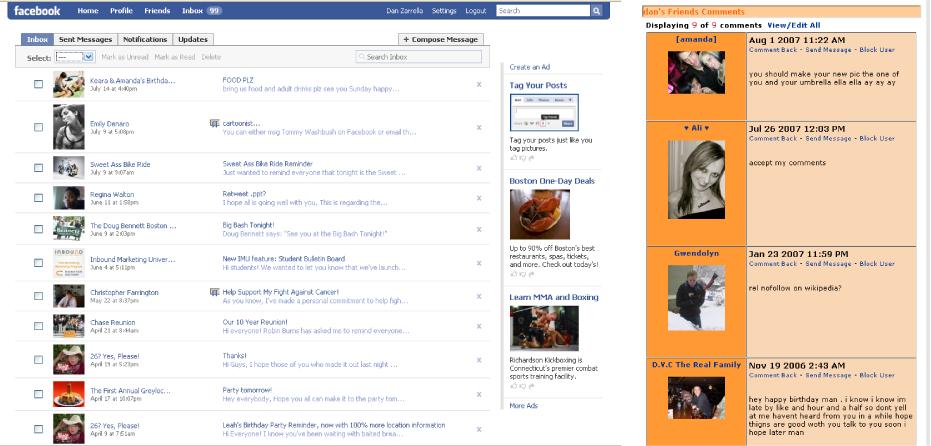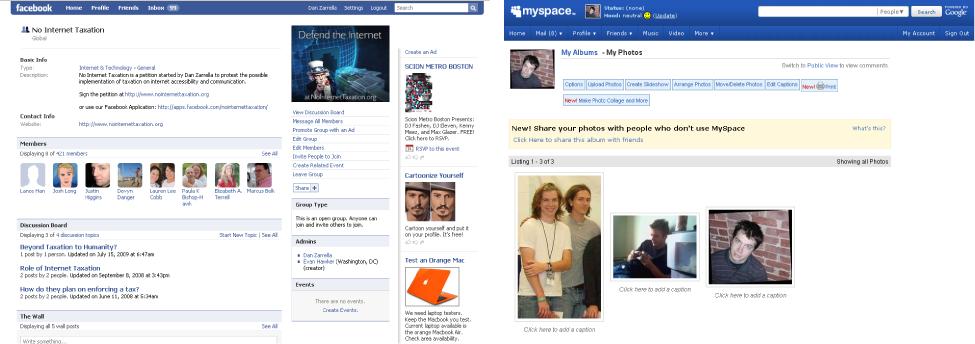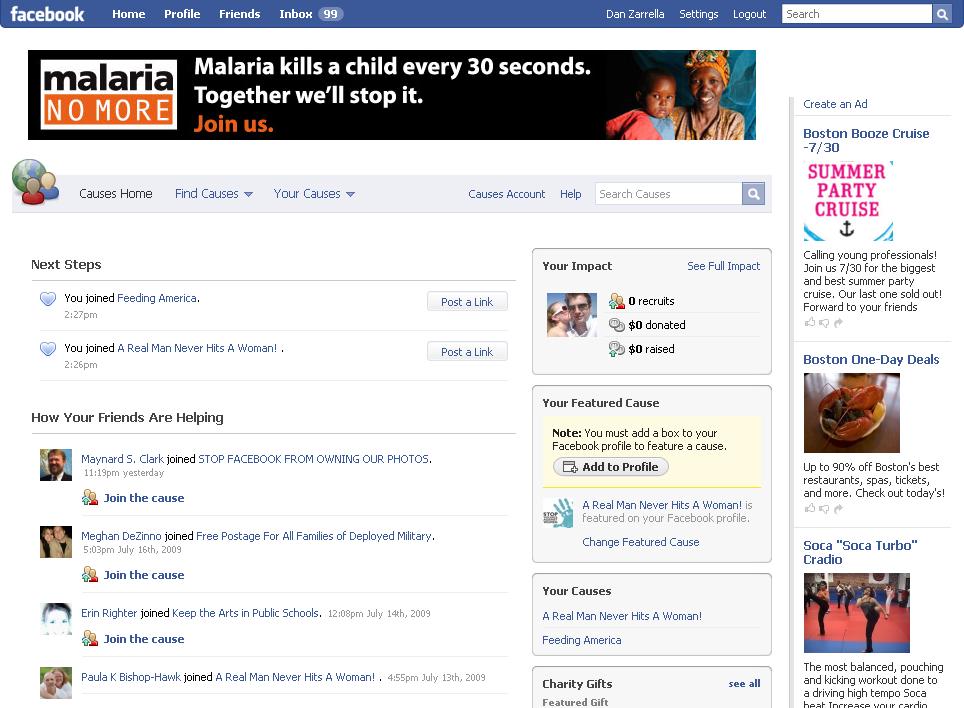Social networking sites vary greatly based on their feature sets and raisons d'être, but there are some common elements across most of them. This section will introduce those elements.
The building blocks of a social network are user pages, known as profiles. Your profile page can include information about you, including employment information, educational history, relationship status, contact information, and interests and hobbies. It can link to your photos and your friends' profiles, and allow visitors to contact you, often through private and public messaging. Social networking sites differ widely in how much they allow you to customize your profile: MySpace allows custom backgrounds and graphics, Facebook lets you add new blocks of content from applications, and LinkedIn gives you very little control. It's a good idea to do whatever you can to make your profile reflect your personality and personal brand, but don't go crazy—everyone hates the seizure-inducing profile with alarmingly loud pop music.
Profiles are for real people. You should have a profile; your company's logo should not. Profiles contain personal information; a brand can't have a favorite movie or book. If your company has a recognizable spokesperson, you can create a profile for him; otherwise, stick to a page or group for your company information.
The most important action of a social network is the act of two people connecting. MySpace considers it friending regardless of the recipient, whereas Facebook reserves friending for individual people and calls it fanning when you connect with a brand. LinkedIn keeps it simple and calls everything connecting (see Figure 4-3).
Social networks were conceived to emphasize strong connections between people—the people you actually know in real life rather than your online buddies. Some users follow this maxim to the letter and will accept connection requests only from people they know well. Other users will connect with just about anyone. In either case, if you're sending a connection request to someone, and it isn't obvious how you know her, you should include a brief introductory sentence or two along with your request explaining why you should be friends.
Social networks impose limits on how many people you can connect to in a given amount of time. These restrictions are in place to thwart spammers trying to build giant networks; if you're running into warnings, you're probably doing something wrong and need to slow down. It's a building process, and there's no reason to go out and get a million friends in one day.
Note
I once worked on a political campaign on Facebook, where we set up a profile for the candidate and began searching for people who were sympathetic to the candidate's causes to friend. After a burst of connecting to lots of potential supporters, the site would warn us that we were sending too many requests, and eventually the account was suspended. Although our account was reinstated after we sent a few emails to tech support, the exact limit was never revealed—all Facebook ever said was "too many."
Social networks all contain some form of private messaging akin to email (see Figure 4-4). These are typically sent from one user to another, but they can also be sent by a group to all of the group's friends. The networks will generally send the recipient an email notification of a received message, so don't bombard people's inboxes with constant message spam. If you find yourself wondering how to automatically send these messages, you're doing something wrong.
Public messages are called comments in MySpace and wall messages in Facebook. Commenting sections can be found on profiles, photos, groups, events, and business pages. When posting a public message, remember that everyone can read it. Don't share anything you wouldn't send to your boss and your mother. Congratulations, happy birthday, good luck, and long-time-no-see messages are all popular public messaging topics.
Marketers have been guilty of spamming the public message sections of related groups and pages—for example, while working for that politician I mentioned earlier, we were warned about "too many" wall posts. But don't be afraid to congratulate people on recent accomplishments.
Most social networks contain the concept of a group—a collection of people joined by some common interest (see the lefthand side of Figure 4-5 for an example). Group members can share news and discussions, and the group's administrators can send private messages to everyone.
Nonmarketers create groups for a plethora of reasons, including the I-lost-my-cell-so-send-me-your-numbers group and the save-such-and-such-TV-show group. Starting and joining a group requires only a small amount of commitment in time and resources, and little to no member involvement; as a result, many people belong to tons of seemingly pointless groups. LinkedIn is the exception to this rule, as it displays the logos of the groups you're a member of on your profile, meaning that many users are more selective in deciding which groups to join.
One of the most popular features of social networking sites is the ability to share photos. In fact, Facebook's photo-sharing feature is more popular than all of the other photo-sharing sites on the Web combined. You can upload pictures of yourself and your friends, and tag people in the images with their names. Photos can also have their own comment sections, allowing you and your friends to talk about them.
Campaigns can be designed to encourage users to take photos that include your product and to post them to Facebook and MySpace (see the righthand side of Figure 4-5 for an example of MySpace photos).
Most social networks will allow you to create an event and invite your friends to attend it. These events most commonly occur in the real world, but some are online-only events. RSVP functionality is included, as are commenting and photo uploads.
Anytime you're hosting a local event, set up a social networking event page. Use it to invite all your business's fans to come and meet people from your company.
Social networks have exposed their functionality through application programming interfaces (APIs) to developers, allowing them to create applications that plug into their site. Some applications function as add-ons to a profile or page enhancing that functionality, whereas others work more like standalone applications inside the network that leverage the functionality contained in the site.
Some of the most popular applications extend existing social networking functionality by enhancing public messaging systems, adding calendars, or allowing you to indicate which connections you're related to. Other popular apps facilitate philanthropy (as shown in Figure 4-6), or allow you to play games such as Scrabble and poker with your friends.
Applications require technical resources and programming capabilities, but they can be worthwhile additions to a social media marketing campaign. The best apps will allow people to communicate and interact with their friends rather than just act as advertisements for a product.
Several social networking sites have begun to allow their users to post messages answering a simple question: "What are you doing?" The social networking equivalent of instant message (IM) away messages, status updates were originally just short text messages, but Facebook has begun to allow users to post images, links, and videos in their status updates as well. Status messages are often integrated with public messaging systems, allowing your friends to comment on your updates. Many people log in to social networks regularly just to read the status updates of their friends and stay up-to-date on their whereabouts and activities.
Privacy is a sticky issue on social networks. Older users are generally more concerned about and aware of privacy. Younger users revel in sharing minute details of their lives with their entire social networks, and often need to be reminded that some content may be embarrassing or problematic later in life. If you're in marketing, you'll probably want to have open settings to connect with as many people as possible.
Keep in mind the age of your audience when planning a social media marketing campaign, and be sure not to ask for information that is more personal than your audience would feel comfortable providing. Also, carefully review the terms of service (ToS) of each social network before launching a campaign.
Get The Social Media Marketing Book now with the O’Reilly learning platform.
O’Reilly members experience books, live events, courses curated by job role, and more from O’Reilly and nearly 200 top publishers.





